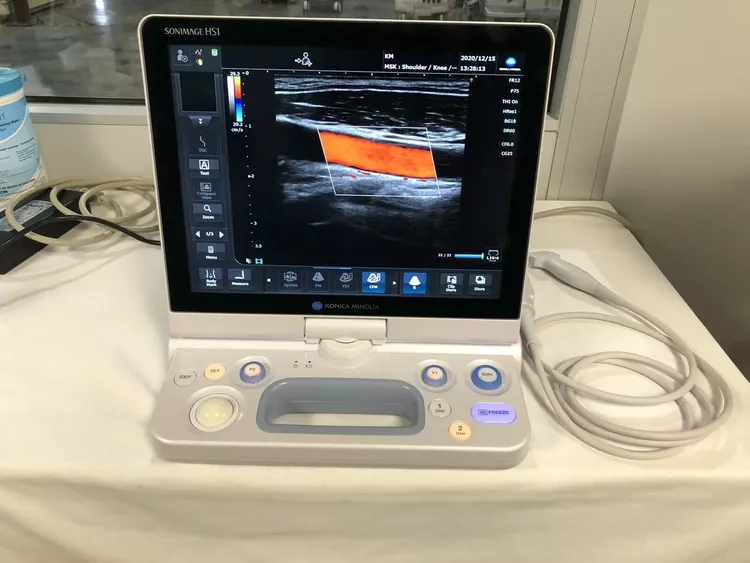Konica, Minolta Sonimage HS1
ASIA (South East)
The SONIMAGE® HS1 Compact Ultrasound System has
advanced MSK functionality providing superior image detail
and contrast resolution. The advanced technological features and high resolution image quality supports
confident diagnosis, needle guidance for
interventional procedures and treatment management at
the point-of-care.
Features
ULTRAADJUST™
The UltraAdjust image optimization feature allows imaging
parameters to be changed by simply adjusting depth.
Various imaging parameters such as trapezoid setting,
contrast enhancements, SI filter and focus position are
automatically optimized “with the touch of the depth button”
Improved Workflow
MSK presets linked to anatomical structures are
optimized when depth is adjusted
VOICE CONTROL
Voice activation of the SONIMAGE® HS1 Ultrasound System
allows for handsfree operation during
interventional procedures
Simple and accurate voice activation
Handsfree system operation
No need to break the sterile field
Focus more on the patient
Enhance diagnostic efficiency
The HS1 System voice control operation feature fosters user
comfort and proper operator ergonomics at the point-of-care.
PANORAMIC VIEW
Panoramic view is an imaging process that produces a
panoramic image that provides both qualitative and
quantitative information. Panoramic imaging stitches a
series of images to give one long image in order to:
Assess larger lesions
Construct a cross-section image of a structure
Show the relationship of two structures in a single image
Panoramic imaging technology widens the field of view for
precise clinical diagnosis and interventional procedures.
ELASTOGRAPHY
Strain Elastography is a real-time qualitative and
quantitative imaging software feature that calculates and
displays the relative stiffness of tissue. The image is
generated from strain generated by uniform pressure of
the transducer on the tissue. Use elastography to visibly assess
changes in tendon and ligament elasticity.
BROAD FREQUENCY LINEAR TRANSDUCERS
Unique nanofabrication technology, combines both material
and machining expertise, to produce the SONIMAGE HS1 L18-4
linear transducer. This broad frequency linear probe offers
both high sensitivity as well as greater penetration,
to scan both deep and superficial joints and structures.
Konica Minolta releases the new HL18-4 hockey stick linear
transducer for musculoskeletal (MSK) and pain management
applications. The hockey stick probe reaches difficult to
access areas easily with its small footprint and maneuverability.
The clinician can evaluate joints in the fingers and ankle more
readily with the probe’s angulation, improved control and
greater contact with the anatomy.
The high frequency probe provides excellent resolution in
the near field for tissue differentiation and visualizes color flow
with outstanding Doppler sensitivity.
SNV™ (SIMPLE NEEDLE VISUALIZATION)
The SONIMAGE HS1 Simple Needle Visualization (SNV™) feature
incorporates an advanced algorithm that utilizes both the in
plane and out-of-plane methods to improve needle visibility,
especially in steep angle approaches. The resulting clarity of
the needle, both tip and shaft, enables increased accuracy in
needle placement, making the portable ultrasound system an
ideal solution for pain management guided injections.
RHEUMATOLOGY REPORTING PACKAGE
The SONIMAGE HS1 Rheumatology report package is an
efficient way to track and organize ultrasound images.
Still images along with real time clips can be stored and
assigned to each joint. The RA protocol is integrated and
customizable. It can be operated from a foot switch allowing
the user to move rapidly through the exam without taking their
hands off of the probe.
REMOTE ASSIST
From the office, receive remote consultation with
Remote Assist. This virtual feature can trouble shoot the
system, optimize an image, provide follow up
applications support, and offer educational training.
And the physician and staff never have to leave the facility.
Konica Minolta Sonimage HS1 Ultrasound Machine Specs
Simple and accurate voice activation
Handsfree system operation
No need to break the sterile field
Focus more on the patient
Enhance diagnostic efficiency

